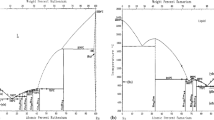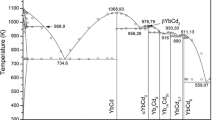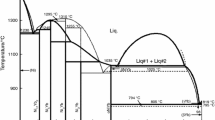Abstract
The Na2O-B2O3 system is thermodynamically optimized by means of the CALPHAD method. A two-sublattice ionic solution model, (Na+1)P(O−2,BO3 −3,B4O7 −2,B3O4.5)Q, has been used to describe the liquid phase. All the solid phases were treated as stoichiometric compounds. A set of thermodynamic parameters, which can reproduce most experimental data of both phase diagram and thermodynamic properties, was obtained. Comparisons between the calculated results and experimental data are presented.
Similar content being viewed by others
References
H.G. Kim, J.K. Kang, S.J. Park, S.J. Chung: “Growth of the Non-Linear Optical Crystals of Lithium Triborate and Beta Barium Borate,” Opt. Mater., 1998, 9(1–4), pp. 356–60.
L. Kaufman and K. Bernstei: Computer Calculation of Phase Diagrams, Academic Press, New York, 1970.
H. Yu, Q. Chen, and Z.P. Jin: “Thermodynamic Assessment of the CaO-B2O3 System,” Calphad, 1999, 23(1), pp. 101–12.
H. Yu, Q. Chen, and Zh. Jin: “Thermodynamic Assessment of the BaO-B2O3 System,” J. Phase Equilibria, 1999, 20(5), pp. 479–84.
H. Yu, H.S. Liu, and Z.P. Jin: “Thermodynamic Calculation of the Li2O-BaO-B2O3 Pseudo-Ternary Phase Diagram,” Z. Metallkd, 1999, 90(7), pp. 499–504.
H. Yu, Z.P. Jin, Q. Chen, and M. Hillert: “Thermodynamic Assessment of the Li2O-B2O3 System,” J. Am. Ceram. Soc., 2000, 83(11), pp. 3082–88.
G.W. Morey and H.E. Merwin: “Phase Equilibrium Relations in the Binary System, Sodium Oxide-Boric Oxide with Some Measurements of the Optical Properties of the Glasses,” J. Am. Chem. Soc., 1936, 58, pp. 2248–54.
T. Milman and R. Bouaziz: “Contribution A L’etude des Borates de Sodium,” Ann. Chim., 1968, 3(4), pp. 311–21 (in French).
J.K. Liang, C.M. Fang, and Q.Z. Huang: “The Mechanism of the Formation and Crystallization of the Glasses in the NaBo2-B2O3 System,” Acta Phys. Sin., 1990, 39(1), pp. 129–37 (in Chinese).
H. Li and J.K. Liang: “Dependence of Crystallization Behavior of Sodium Diborate (Na2O · 2B2O3) on Its Glass Structure and the Characteristics of Phase Transformation,” J. Am. Ceram. Soc., 1995, 78(2), pp. 470–78.
F.E. Wagstaff and R.J. Charles: “Metastable Liquid Immiscibility in the Na2O-B2O3 System,” Am. Ceram. Soc. Bull., 1966, 45(4), p. 420.
R.R. Shaw and D.R. Uhlmann: “Subliquidus Immiscibility in Binary Alkali Borates,” J. Am. Ceram. Soc., 1968, 51(7), pp. 377–82.
R.L. Hervig and A. Navrotsky: “Thermochemistry of Sodium Borosilicate Glasses,” J. Am. Ceram. Soc., 1985, 68(6), pp. 314–19.
M. Fan: Ph.D. Thesis, RTWH, Aachen, Germany, 1991.
M. Itoh, S. Sato, and T. Yokokawa: “Emf Measurements of Molten Mixtures of Lithium Oxide+, Sodium Oxide+, and Potassium Oxide + Boron Oxide,” J. Chem. Thermodynamics, 1976, 8, pp. 339–52.
W. Stegmaier and A. Dietzel: Glastech. Ber., 1940, 18, p. 353.
S. Sato, T. Yokokawa, H. Kita, and K. Niwa: J. Electrochem. Soc., 1972, 119, pp. 1524–26.
H. Itoh, A. Sasahira, T. Maekawa, T. Yokokawa: “Electromotive-Force Measurements of Molten Oxide Mixtures, Part 8: Thermodynamic Properties of Na2O-B2O3 Melts,” J. Chem. Soc., Farad. Trans., 1984, 80, pp. 473–87.
J.H. Park and D.J. Min: “Thermodynamic Behavior of Na2O-B2O3 Melt,” Metall. Mater. Trans. B, 2001, 32B(4), pp. 297–303.
M.M. Shul’ts, V.L. Stolyarov, G.A. Semenov: “A Study of the Thermodynamic Properties of Melts in the 2NaBO2-B2O3 System Using a Mass Spectrometric Method,” Fiz. Khim. Stekla, 1979, 5, pp. 42–51.
L. Shartsis and W. Capps: “Energy Relations in Binary Alkali Borates,” J. Am. Ceram. Soc., 1954, 37(1), pp. 27–32.
G.S. Smith and G.E. Rindone: “High-Temperature Energy Relations in the Alkali Borates: Binary Alkali Borate Compounds and Their Glasses,” J. Am. Ceram. Soc., 1961, 44(2), pp. 72–78.
O. Kubaschewski, C.B. Alock, and P.J. Spencer: Metallurgical Thermochemistry, 6th ed., Pergamon Press, New York, 1993.
M. Hillert and X. Wang: “A Study of the Thermodynamic Properties of MgO-SiO2 System,” Calphad, 1989, 13(3), pp. 253–66.
M. Hillert, B. Sundman, and X. Wang: “An Assessment of the CaO-SiO2 System,” Metall. Trans. B, 1990, 21B(2), pp. 303–12.
B. Sundman, B. Jansson and J-O. Andersson: “The Thermo-Calc Databank System,” Calphad, 1985, 9(2), pp. 153–90.
Author information
Authors and Affiliations
Rights and permissions
About this article
Cite this article
Wang, C., Yu, H., Liu, H. et al. Thermodynamic optimization of the Na2O-B2O3 pseudo-binary system. JPE 24, 12–20 (2003). https://doi.org/10.1007/s11669-003-0003-7
Received:
Revised:
Published:
Issue Date:
DOI: https://doi.org/10.1007/s11669-003-0003-7




